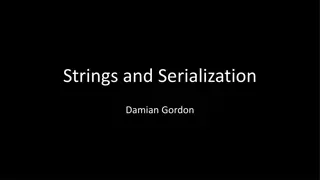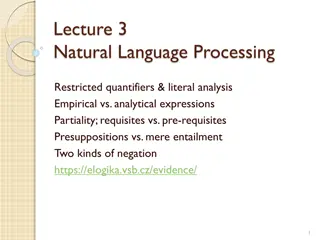Understanding Declarative Programming and Regular Expressions
Declarative programming emphasizes describing the desired result rather than the computational processes, leading to domain-specific languages designed for specific problem domains. Regular expressions offer powerful pattern matching capabilities facilitating tasks such as parsing, querying databases, and describing logical relations like in Prolog. This content delves into the nuances of declarative programming, highlighting the importance of languages like Regular Expressions in various domains.
- Declarative Programming
- Regular Expressions
- Domain-specific Languages
- Pattern Matching
- Computational Processes
Download Presentation

Please find below an Image/Link to download the presentation.
The content on the website is provided AS IS for your information and personal use only. It may not be sold, licensed, or shared on other websites without obtaining consent from the author. Download presentation by click this link. If you encounter any issues during the download, it is possible that the publisher has removed the file from their server.
E N D
Presentation Transcript
Declarative programming (review) In imperative languages: A "program" is a description of computational processes The interpreter carries out execution/evaluation rules In declarative languages: A "program" is a description of the desired result The interpreter figures out how to generate the result
Domain-specific languages Many declarative languages are domain-specific: they are designed to tackle problems in a particular domain, instead of being general purpose multi-domain programming languages. Language Domain Regular expressions Pattern-matching strings Backus-Naur Form Parsing strings into parse trees SQL Querying and modifying database tables HTML Describing the semantic structure of webpage content CSS Styling webpages based on selectors Prolog Describes and queries logical relations
Pattern matching Pattern matching in strings is a common problem in computer programming. An imperative approach: def is_email_address(str): parts = str.split('@') if len(parts) != 2: return False domain_parts = parts[1].split('.') return len(domain_parts) >= 2 and len(domain_parts[-1]) == 3 An equivalent regular expression: (.+)@(.+)\.(.{3}) With regular expressions, a programmer can just describe the pattern using a common syntax, and a regular expression engine figures out how to do the pattern matching for them.
Matching exact strings The following are special characters in regular expressions: \ ( ) [ ] { } + * ? | $ ^ . To match an exact string that has no special characters, just use the string: Provo, UT 84602 Matches: Provo, UT 84602 But if the matched string contains special characters, they must be escaped using a backslash. \(1\+3\) Matches: (1+3)
The dot The . character matches any single character that is not a new line. .a.a.a Matches: banana It also matches: Canada It's typically better to match a more specific range of characters, however..
Character classes Pattern Description Denotes a character class. Matches characters in a set (including ranges of characters like 0-9). Use [^] to match characters outside a set. Matches any character other than the newline character. Matches any digit character. Equivalent to [0-9]. \D is the complement and refers to all non-digit characters. Matches any word character. Equivalent to [A-Za-z0-9_]. \W is the complement. Example Matches: t , o, or p [] [top] 1?, 12, 1!, 1B, . 1. 12, 62, 20 \d \d\d 11, 1A, 3F \w \d\w 7 a, 3 Z, 4 F Matches any whitespace character: spaces, tabs, or line breaks. \S is the complement. \s \d\s\w
Quantifiers These indicate how many of a character/character class to match. Pattern Description Example Matches: a , aa, aaa, * a* Matches 0 or more of the previous pattern lol, lool, loool, + lo+l Matches 1 or more of the previous pattern. ll, or lol ? lo?l Matches 0 or 1 of the previous pattern. Used like {Min, Max}. Matches a quantity between Min and Max of the previous pattern. If only a single number is given, it must have exactly that number of characters aa, aaa, or aaaa {} a{2,4}
Anchors These don't match an actual character; they indicate the position where the surrounding pattern should be found. Pattern Description Example Matches: aww aw ^ ^aw+ Matches the beginning of a string Stay away $ \w+y$ Matches the end of a string. Matches a word boundary, the beginning or end of a word. A blue tent \b \w+e\b
Combining patterns Patterns P and P can be combined in various ways. Combination Description Example Matches: A match for P followed immediately by one for P . ab. or ab, ab[.,] P P Matches anything that either P or P does. 1, 12, 523, Inf, \d+|Inf P |P Matches whatever P does. Parentheses group, just as in arithmetic expressions. <3, <3<3, <3<3<3, (<3)+ (P )
Support for regular expressions Regular expressions are supported natively in many languages and tools. Languages: Perl, ECMAScript, Java, Python, .. Tools: Excel/Google Spreadsheets, SQL, BigQuery, VSCode, grep, ...
Raw strings In normal Python strings, a backslash indicates an escape sequence, like \n for new line or \b for bell. >>> print("I have\na newline in me.") I have a newline in me But backslash has a special meaning in regular expressions. To make it easy to write regular expressions in Python strings, use raw strings by prefixing the string with an 'r': pattern = r"\b[ab]+\b"
The re module The re module provides many helpful functions. Function Description returns a match object representing the first occurrence of pattern within string re.search(pattern, string) returns a match object, requiring that pattern matches the entirety of string re.fullmatch(pattern, string) returns a match object, requiring that string starts with a substring that matches pattern re.match(pattern, string) returns a list of strings representing all matches of pattern within string, from left to right re.findall(pattern, string) substitutes all matches of pattern within string with repl re.sub(pattern, repl, string)
Match objects The functions re.match, re.search, and re.fullmatch all take a string containing a regular expression and a string of text. They return either a Match object or, if there is no match, None. re.fullmatch requires that the pattern matches the entirety of the string: import re re.fullmatch(r'-?\d+', '123') # <re.Match object> re.fullmatch(r'-?\d+', '123 peeps') # None Match objects are treated as true values, so you can use the result as a boolean: bool(re.fullmatch(r'-?\d+', '123')) # True bool(re.fullmatch(r'-?\d+', '123 peeps')) # False
Inspecting a match re.search returns a match object representing the first occurrence of pattern within string. title = "I Know Why the Caged Bird Sings" bool(re.search(r'Bird', title)) # True Match objects also carry information about what has been matched. The .group() method allows you to retrieve it. x = "This string contains 35 characters." mat = re.search(r'\d+', x) mat.group(0) # '35'
Match groups If there are parentheses in a patterns, each of the parenthesized groups will become groups in the match object. x = "There were 12 pence in a shilling and 20 shillings in a pound." mat = re.search(r'(\d+)[a-z\s]+(\d+)', x) mat.group(0) mat.group(1) mat.group(2) mat.groups() # '12 pence in a shilling and 20' # '12' # '20' # ('12', '20')
Finding multiple matches re.findall() returns a list of strings representing all matches of pattern within string, from left to right. locations = "AL 36362, MD 21221, UT 84660" re.findall(r'\d\d\d\d\d', locations) # ['36362', '21221', '84660']
Reusing a Regular Expression Often, we may want to reuse a regular expression on multiple strings. When that is the case, we can use the compile() function to create a regular expression object that can be reused regex = re.compile(r'\d{5}') The same functions we saw in the previous slides can be called on this object, but we no longer need to pass in the expression, it already knows what that is locations = "AL 36362, MD 21221, UT 84660" regex.findall(locations) # ['36362', '21221', '84660'] locations2 = "UT 84602, MD 20740, CA 94043" regex.findall(locations2) # ['84602', '20740', '94043'] This can be more efficient as it only has to figure out how to identify the string once, instead of recreating it each time we call the function.
Ambiguous matches Regular expressions can match a given string in more than one way. Especially when there are parenthesized groups, this can lead to ambiguity: mat = re.match(r'wind|window', 'window') mat.group() # 'wind' mat = re.match(r'window|wind', 'window') mat.group() # 'window' mat = re.match(r'(wind|window)(.*)shade', 'window shade') mat.groups() # ('wind', 'ow ') mat = re.match(r'(window|wind)(.*)shade', 'window shade') mat.groups() # ('window', ' ') Python resolves these particular ambiguities in favor of the first option.
Ambiguous quantifiers Likewise, there is ambiguity with *, +, and ?. mat = re.match(r'(x*)(.*)', 'xxx') mat.groups() # ('xxx', '') mat = re.match(r'(x+)(.*)', 'xxx') mat.groups() # ('xxx', '') mat = re.match(r'(x?)(.*)', 'xxx') mat.groups() # ('x', 'xx') mat = re.match(r'(.*)/(.+)', '12/10/2020') mat.groups() # ('12/10', '2020') Python chooses to match greedily, matching the pattern left-to-right and, when given a choice, matching as much as possible while still allowing the rest of the pattern to match.
Lazy operators Sometimes, you don t want to match as much as possible. The lazy operators *?, +?, and ?? match only as much as necessary for the whole pattern to match. mat = re.match(r'(.*)(\d*)', 'I have 5 dollars') mat.groups() # ('I have 5 dollars', '') mat = re.match(r'(.*?)(\d+)', 'I have 5 dollars') mat.groups() # ('I have ', '5') mat = re.match(r'(.*?)(\d*)', 'I have 5 dollars') mat.groups() # ('', '') The ambiguities introduced by *, +, ?, and | don t matter if all you care about is whether there is a match!
A word of caution Regular expressions can be very useful. However: Very long regular expressions can be difficult for other programmers to read and modify. See also: Write-only Since regular expressions are declarative, it's not always clear how efficiently they'll be processed. consuming, it can take down a server. Some processing can be so time- Regular expressions can't parse everything! Don't write an HTML parser with regular expressions.























